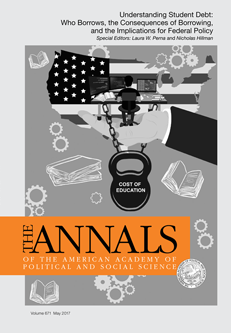Is student debt a policy problem? 41.5 million Americans owe more than $1.2 trillion in outstanding federal loan debt and the debt load carried by American college-goers and their families has tripled over the past decade. But less than half of all undergraduates take out federal loans annually, and the median loan balance for all borrowers is about $14,000 – a significant sum but not a “crushing” debt for many borrowers, particularly for those who attain degrees and enjoy the significant economic returns that post-secondary education can bring.
There is no “typical” experience of student debt felt by college-goers and their families, and no single problem shared by all borrowers. This makes policymaking in higher education challenging, because it’s hard to know exactly how student aid should be directed and administered in order for it to have the greatest possible public benefit.
This volume of The ANNALS presents new evidence on who borrows, why they borrow, and the consequences of student loan debt. We also present new work on federal loan repayment programs, focusing on default and repayment rates, the costs of income-driven repayment and loan forgiveness programs, and strategies for reducing repayment burdens. This collection of papers advances our understanding of a wide range of issues, including debt aversion, financial literacy, simplifying the aid application and loan repayment process, costs of income-driven repayment, debt burdens upon graduation, and federal accountability and consumer protection policies.

